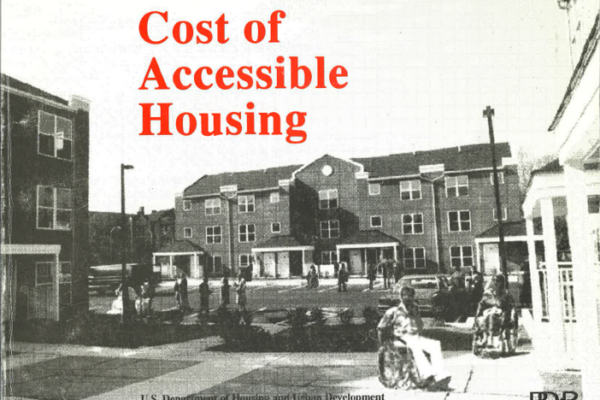

Blog
When accessibility compliance is overlooked during design and construction, the consequences can extend far beyond legal exposure.

The intrinsic connection between accessibility, sustainability, and building performance is undeniable. Designing and constructing buildings in compliance with accessibility requirements established by laws and building codes is not only a legal obligation, but also a critical strategy for minimizing carbon emissions and protecting long-term energy performance.
Federal laws like the Americans with Disabilities Act, the Fair Housing Act, the Architectural Barriers Act, and Section 504 of the Rehabilitation Act, along with state and local laws and building codes, establish clear mandates for accessible design and construction. These mandates help to ensure that physical barriers to access are removed from the built environment.
Ensuring buildings are accessible from day one safeguards their energy efficiency, reduces environmental impact, and protects owners and developers from costly legal consequences—resulting in enhanced long-term value for owners and occupants alike.
Let’s explore the connection between accessibility, sustainability, and building performance with some scenarios our consultants have encountered on various projects:
Retrofits to correct noncompliance with accessibility requirements may involve demolition, reconstruction, and material replacement, all of which contribute to additional embodied carbon associated with the production, transportation, installation, maintenance, and disposal of building materials. Simply put, embodied carbon is a building’s “carbon footprint” before it becomes operational.
Noncompliant slopes along accessible routes are commonly identified during an accessibility compliance assessment. To comply, accessible routes connecting site arrival points with a building entrance must have a cross slope of no more than 2% and a running slope of no more than 5%. Ramps are permitted to have a running slope of up to 8.33%.
Concrete is a substantial contributor to the embodied carbon emissions of buildings.
When correcting noncompliant slopes along a network of concrete sidewalks and ramps requires replacement—which is often the case—embodied carbon emissions, i.e., greenhouse gas emissions, are greatly increased.
Therefore, violating accessibility requirements has a negative impact on a building’s carbon footprint.
Another example is interior renovations. SWA was recently retained to help a client navigate a settlement agreement resulting from litigation brought by a plaintiff alleging noncompliance with accessibility requirements.
The developer was required by the settlement agreement to reconfigure 330 dwelling unit kitchens, including the replacement of kitchen cabinets, countertops, flooring, and, in some cases, appliances and walls.
The impact on embodied carbon in this case was substantial, between the extensive material replacement and the construction activity.
Environmental and operational repercussions from post-construction renovations, often triggered by litigation or complaints alleging noncompliance with accessibility requirements, can be substantial and enduring.
Door thresholds that are too high are another common violation of accessibility requirements identified during an accessibility compliance inspection. A threshold that’s too high can make it nearly impossible for someone using a wheelchair to enter a building. Replacing existing thresholds with new low-profile thresholds is often required post-construction to satisfy accessibility requirements.
In the case of exterior doors, this can go beyond just replacing the threshold itself; it can require replacing entire storefront elements or reconfiguring interior flooring and exterior ground surfaces to achieve a compliant condition.
If accessibility compliance is overlooked during the design of a building meeting Passive House standards, then chances are that the building will include a threshold that is higher than permitted by accessibility mandates.
Higher thresholds in Passive House buildings are common due to the goal of minimizing thermal bridging at the threshold by use of gaskets and weather stripping. Replacing thresholds installed to meet Passive House standards because they violate accessibility mandates not only compromises the building’s energy performance, but also negatively impacts carbon emissions.
Millions of dollars are invested to design sustainable, energy efficient, and resilient buildings, but how much of that investment is lost due to the cost of litigation, retrofitting, and renovation related to accessibility violations?
In the early ‘90s, the U.S. Department of Housing and Urban Development (HUD) funded a study to determine the cost of complying with the Fair Housing Act before the industry fully understood the requirements for new multifamily buildings.

The research, led and conducted in part by SWA, concluded that building housing that is accessible to all and in compliance with the Fair Housing Act did not come at an excessive cost when accessibility was considered from the start of the design process. (Click here to flip through the original Cost of Accessible Housing report via Google Books.)
At the time of this research, energy efficiency wasn’t a major focus for new buildings. Today, it’s central, but we still lack updated research that quantifies the cost of accessibility-related litigation, renovations, and even reputational damage for new buildings as well as the impact of these consequences on sustainability goals.
Green building certification programs like LEED and Passive House do not currently account for post-construction changes. If a building must undergo significant renovations to meet accessibility standards, should that affect its sustainability rating? There is no mechanism to reassess energy performance or embodied carbon after such renovations.
However, it is worth noting that some jurisdictions may soon require “as-built” embodied carbon assessments, which could account for changes due to noncompliance.
One step beyond this is integrating accessibility into green building programs so that accessibility requirements are met from the start prior to decisions about sustainability features. This will help close a critical gap in today’s certification programs.
LEED has made some progress here by incorporating an “Accessibility and Inclusion” credit into its latest version, LEED v5 (see the credit for New Construction, Core and Shell, and Commercial Interiors), but the credit is optional.
Energy efficiency is driven by incentives, while accessibility is driven by legal requirements. Expanding incentives for accessibility will do just that—incentivize more project teams to treat accessibility the same way they treat sustainability, as well as avoid costly litigation and renovation from violating accessibility requirements.
The imbalance in the market today can lead to accessibility being deprioritized, even though a building can’t truly be sustainable if it isn’t accessible.
As energy incentives are being reduced, there’s concern that accessibility requirements may also come under threat. We need to ensure that both remain central to the future of building design.
Accessibility and sustainability both demand attention to detail—whether it’s thermal bridging, air infiltration, or a threshold that’s just a few millimeters too high.
Proactively integrating accessible design and construction from the outset ensures that buildings are inclusive, while also maintaining the integrity of sustainable design strategies.
When accessibility is the baseline for design, it’s not just about compliance; it’s about risk management, performance, and long-term value.
Continuing the dialogue about the intrinsic connection between accessibility, sustainability, and building performance is key. But what’s even more important is taking the actions above to make sure that accessibility is not an afterthought.
Reach out to us through our contact form if you have questions or know about opportunities for research on this topic.
Author: Peter Stratton, Managing Director of Accessibility Services
Steven Winter Associates